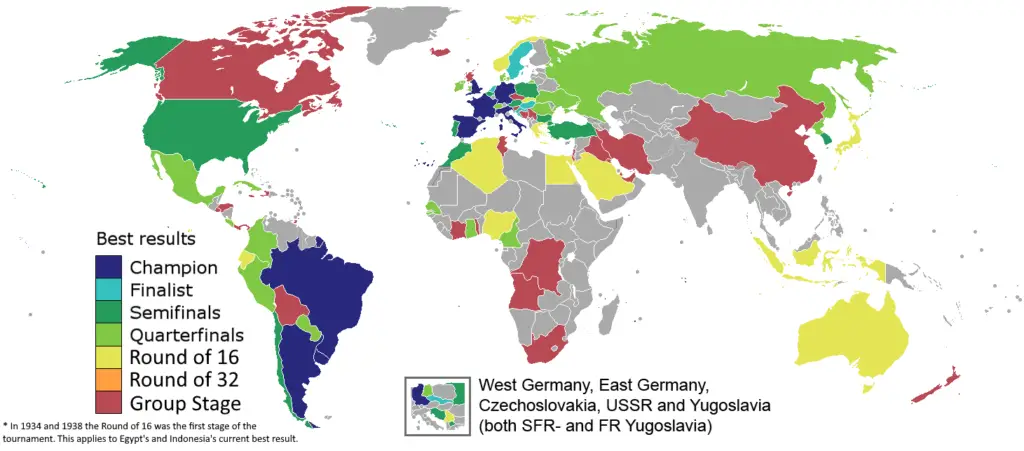The Geography of Soccer Success: A World Cup Story
Table of Contents

Looking at this fascinating world map of FIFA World Cup achievements, the colors tell an intriguing story of soccer success across the globe. The dark blue regions represent the champions, turquoise shows the finalists, dark green marks the semifinalists, and light green indicates quarterfinalists. Yellow represents countries reaching the round of 16, orange shows those making it to round of 32, while red marks nations that only reached the group stage.
One striking pattern immediately catches the eye – all World Cup-winning nations share borders with each other, forming a remarkable chain of soccer excellence. Let’s dig deeper into this geographical phenomenon and uncover what makes certain countries more successful in the beautiful game.
The Elite Club: Updated World Cup Winners
As of 2022, only eight nations have lifted the prestigious FIFA World Cup trophy, with the most recent addition being Argentina’s triumph in 2022:
- Brazil (5 titles: 1958, 1962, 1970, 1994, 2002)
- Germany (4 titles: 1954, 1974, 1990, 2014)
- Italy (4 titles: 1934, 1938, 1982, 2006)
- Argentina (3 titles: 1978, 1986, 2022)
- France (2 titles: 1998, 2018)
- Uruguay (2 titles: 1930, 1950)
- England (1 title: 1966)
- Spain (1 title: 2010)
The Geographic Connection
The “champions corridor” stretches from Uruguay through Brazil, and Argentina, moving across the Atlantic to connect with Spain, France, England, Germany, and Italy. This geographic clustering isn’t just coincidence – it reflects several key factors:
- Cultural Exchange: Neighboring countries naturally influence each other through regular competition, shared soccer philosophies, and player movement across borders.
- Historical Development: Soccer spread through these regions early in its history, allowing for deeper roots and stronger soccer traditions.
- Economic Factors: These nations historically had resources to develop strong soccer infrastructure and youth programs.
Interesting Facts
- Brazil remains the only nation to have played in every World Cup tournament since its inception in 1930.
- The 2022 World Cup final between Argentina and France was watched by an estimated 1.5 billion people worldwide, making it one of the most-watched sporting events in history.
- The champions have scored a combined total of 156 goals in World Cup finals matches alone.
- Lionel Messi became the first player to win the Golden Ball (best player) award twice, in 2014 and 2022.
Why Some Countries Excel While Others Don’t
Several factors contribute to national soccer success:
- Infrastructure: Countries with well-developed youth academies and professional leagues tend to perform better.
- Population Size: Larger populations provide a bigger talent pool, though this isn’t always decisive (Uruguay proves this point).
- Economic Resources: The ability to fund soccer development programs and maintain quality facilities plays a crucial role.
- Cultural Priority: In countries where soccer is the dominant sport, more resources and attention are devoted to its development.








